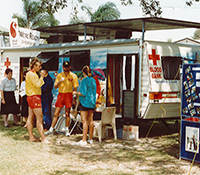◄ Back to Blood Service in Brief July 2016
Until just two decades ago, eight separate Red Cross blood banks in each state and territory collected and supplied blood for Australia.
Each state and territory Red Cross blood transfusion service operated under separate governance and standards. In the aftermath of the HIV and hepatitis C epidemics, it was particularly important to unify and standardise these separate services.
In 1996 they were amalgamated to form the national organisation we have today, the Australian Red Cross Lifeblood. This was nearly 70 years after the Red Cross in Victoria set up Australia’s first volunteer blood transfusion service in 1929.
The Blood Service has come a long way in two decades. Dr Robert Hetzel headed the new national organisation and had the huge task of bringing together eight separate state and territory services with significantly different management structures and systems. Once the services were combined, for the first time blood could be transferred between states to where it was needed most. One game-changing initiative was the National Blood Management System, a $35 million computer system to track all blood donations nationally.
In 2000, Australia was amongst the leading countries to introduce additional high-sensitivity nucleic acid testing for HIV and hepatitis C. By 2003, the number of blood donations collected by the Blood Service in one year reached one million, and we now collect around 1.3 million donations every year.
Jennifer Williams took on the role of Chief Executive in 2009 and further drove national consolidation by streamlining donor management and production systems. Just a few months ago, she handed over to our new Chief Executive, Shelly Park, and we now begin a new era for the Blood Service.
The Blood Service openly embraces industry trends and always focuses on addressing the needs of our customers and community. We are making medical discoveries which the world will benefit from, and continue to expand what we do. We also play a key role internationally, working with blood services around the world and helping third-world countries establish their own safe, reliable blood services.

